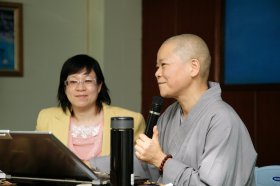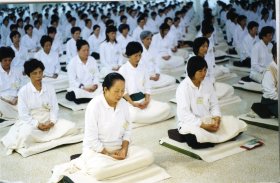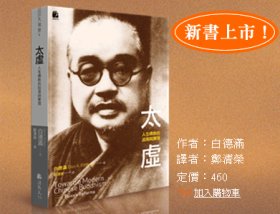Buddhism in Taiwan (Part I)
In order to understand Buddhism in Taiwan, it is necessary to know its origin the Buddha himself and the core of his teaching. Therefore, let's begin with a brief introduction to the Buddha first.
Brief introduction to the origin of Buddhism
Sakyamuni Buddha was born in the 6th century B.C. He was the son of a king in ancient northern India, now Nepal. He was well-protected in the confined palace and had an extremely comfortable life as a prince when he was young.
As he got the chance to go out of the palace, he viewed people in old age, with sickness and the deceased. This experience shocked him so much and made him eventually to leave his wife and family in search for the key to the secrets about human suffering and the way to liberate people from all sufferings in life.

He became a monk and adopted the most severe ascetic practice at the time for 6 years. He then realized that ascetic practice would not lead him to liberation, so he gave it up and tried a different approach on his own. Then through constant practice, he made a breakthrough and pioneered the Way to deliver people from all sufferings.
He thoroughly examined all phenomena and came to a conclusion that all existing things are impermanent, for everything comes into existence due to numerous causes and they are constantly changing all the time. He named such truth as anatman (No-self), because self contains the meaning of being able to exist all alone independently.
Because of such a thorough realization, he let go of his own ego completely and fully freed himself from all the sufferings in life when he was meditating under a big tree. At the same time he had transcended the transmigration of life and death and became the Buddha, the fully awakened one.
After he attained complete enlightenment, the Buddha started to share the truth he had found through his own practice and the method to gain liberation. He traveled around the Ganges River for 45 years, teaching and sharing what he had found until he passed away at the age of 80.
The Buddha's teaching is called the Dharma and the monastic organization of monks and nuns he established is called the Sangha order. In Buddhism, the Buddha, Dharma, and Sangha are called the three jewels for they are the most valuable treasures for a Buddhist. Buddhists like to call themselves the followers of the three jewels who learn the Dharma from the Buddha and the professionals who have devoted their whole life to the practice of Buddhism—the Sangha.

According to Buddhist ideas, all sentient beings have the potential to become a buddha through their own cultivation of wisdom and merits which come from their selfless love for others (more commonly referred to as compassion in Buddhism). The final goal of a Buddhist is to reach Buddhahood, the perfect stage of compassion and wisdom.
So, that is a brief introduction to the origin and key idea of Buddhism, now let’s talk about its introduction to China.
Brief introduction of Buddhism in Chinese history
Buddhism was introduced to China in the first century during the time of Emperor Ming of the East Han Dynasty. It enjoyed great popularity during the Sui (581-618) and Tang (618-907 A. D.) dynasties.
During the Tang dynasty, the great Chinese monk Husan Tsang made the most significant contributions to the faith in China by translating plenty of Sanskrit Buddhist scriptures into Chinese language.
With the efforts of many other great translators in China, India, and central Asia, voluminous high quality scriptures were introduced to China. Hence, Buddhism began its philosophical and practical development in China and eventually 8 schools of the religion flourished during the Tang dynasty. They are the Chan (Zen in Japanese) school, Pure Land, the Vinaya, Secret, San lun, Tien-tai, Hwa yen, and Vijnana schools.
The Chan school is in many aspects the most "Chinese style," and its use of dynamic methods to guide followers toward self-liberation is creative and effective.

Chan master Bai-tzang even adopted and advocated that the lifestyle of Buddhist monastics in China should be a day without work is a day without eating, which is completely different from the lifestyle of Indian Buddhist monks who live on begging alms from the public day after day. Later on, all the Buddhist monasteries in China adopted his idea. They work for their food instead of depending on other people's alms giving.
Chan had even greater influence in Japan and Korea after it was introduced to these two countries from China. In the beginning of the 20th century, D. T. Suzuki was the foremost writer and teacher of Chan in the west, which attracted great interests in Chan Buddhism throughout the world.
As an alien religion, Buddhism encountered a lot of difficulties at the early stage of its introduction to China. It took on many attributes of the local culture to become a Chinese Buddhism, and has eventually rooted in the country and attracted the most population than any other religions in China throughout the history.
Buddhism has in every aspect influenced Chinese people. For example, Buddhist literature has introduced some 35,000 new vocabulary items to the Chinese language, including such terms as equality, freedom, and liberation, etc.
It suggests that much more of the Chinese thoughts have been deepened and broadened by Buddhism. Besides, Buddhist scriptures contain a lot of descriptive religious tales which prompt the development of Chinese fiction and arts. The rhyming hymns also inspired singing stories and other rhyming literature.
 Brief history of Taiwanese Buddhism
Brief history of Taiwanese Buddhism
Now, let's talk about how Buddhism was introduced to Taiwan. At the end of the Ming dynasty, a time when the Dutch ruled the island, Buddhism was introduced to Taiwan by immigrants from Fukien and Kwangtun—the proviences on south-east coast of China.
Later, the Ming dynasty patriot Cheng Cheng-kung (1642-1662) or Koxinya as he is known in the West, started to open up the island, and Buddhism gradually attracted more followers from the local people.
Koxinya's son, Cheng-ching was a Buddhist. He even established a temple in Taiwan. During the Ching dynasty (1644-1911), a large number of monks came to Taiwan to establish temples.
However, during this time, the monks were not very well-educated and they did not know much about Buddhism. Thus, the religion was mixed up with the vegetarian religions and the local faiths.
During the Japanese occupation of Taiwan from 1895 to 1945, schools of Japanese Buddhism influenced the local development of the faith because they were very good at organizing people and publications.
However, the lifestyle of Japanese monks who eat meat and live with their wives and family in the temple was not appreciated by the Taiwanese Buddhists. Thus the Japanese style of Buddhism was not popular in Taiwan.
After Taiwan was returned to the ROC government, and especially after the communists took over mainland China, many great Buddhist monks left China and came to Taiwan. They have inhabited here and have been teaching and spreading Buddhism ever since then.
Among them are the most outstanding masters such as Master Tai-xu's student, Master Yin-shun, and the younger monks such as Master Hsing-yun, and my master, master Sheng-yen, who came to Taiwan as a soldier and became a monk again afterward. All these 3 masters have played vital roles for the flourishing of Buddhism in Taiwan.
There were also a lot of lay Buddhists with high achievements who came to this island after 1949. They have also made significant contribution to the development of the faith in Taiwan. For example, Mr. Chou-shuan-de established the first Buddhist association in the national Taiwan University for the college students.
Later on, a lot of colleges took this example and set up associations among students to learn Buddhism. At present, almost all universities in Taiwan have Buddhist associations on campus.

Many college students got the access to learn Buddhism through these associations and gradually become devoted Buddhists. Some of them even shaved their hair and become monks or nuns.
You may be interested in knowing the structure of Buddhists in Taiwan. Well. There is a Buddhist association in Taiwan. However, unlike the solid and firm structure of the Catholic churchs, the Buddhist association in Taiwan does not have power over the temples and its followers.
In other words, the Buddhist association in Taiwan is rather uninfluencial here. Throughout the history of Buddhism, it has always been the great masters and their organizations which play the vital roles to the flurishing of the faith.
Now I would like to talk about master Tai-xu briefly for he is the most important figure in modern Chinese Buddhism-the root of Taiwanese Buddhism. Master Tai-xu lived in the early 20th century China.
During that time, most of the monks knew little about Buddhism. A lot of Chinese monks made a living by chanting sutras for the deceased. Thus some Confucian scholars criticized Buddhism as a religion for the dead, not for the living people. And the social status of the Buddhist monastics was very low.

Master Tai-xu established several Buddhist colleges, gave talks and wrote voluminous books, trying to help people from different walks of life to apply Buddha's teaching to benefit themselves. He also had revolutionary ideas for enhancing the popularity of Buddhism around the world. In short, he spent all his lifetime promoting Human Life Buddhism.
His student, Master Yin-shun adopted his idea and emphasized Buddhism for the Human Realm. At present, the idea of Human Life Buddhism and Buddhism for the Human Realm are the main ideas of Taiwanese Buddhism.
My grand master, master Dong-chu, who was also a student of Tai-xu was a devoted follower of Master Tai-xu. He dedicated his life spreading the idea of Human Life Buddhism. He influenced both my master and master Hsing-yun who studied in Chiaushan Buddhist college when he was a young monk while master Tong-chu was the director of the college.
(By Guo Hsiang)